A Study on the Relationships between Water Film Thickness, Fresh Properties, and Mechanical Properties of Cement Paste Containing Superfine Basalt Powder (SB)
Abstract
:1. Introduction
2. Materials and Methods
2.1. Materials
2.2. Experiment Plan
2.3. Test Methods
2.3.1. Flow Rate and Flow Spread
2.3.2. Yield Stress and Apparent Viscosity
2.3.3. Cohesiveness
2.3.4. Bleeding Rate
2.3.5. Compressive Strength
2.3.6. Void Ratio, Packing Density and WFT
3. Results and Discussion
3.1. The Effect of WFT on Fresh Properties of Cement Paste Containing SB
3.1.1. Void Ratio, Packing Density, and WFT
3.1.2. Flow Spread and Flow Rate versus W/CM Ratio and WFT
3.1.3. Apparent Viscosity and Yield Stress W/CM Ratio Versus WFT
3.1.4. Cohesiveness Versus W/CM Ratio and WFT
3.1.5. Bleeding Rate versus W/CM Ratio and WFT
3.1.6. Compressive Strength versus W/CM Ratio and WFT
3.2. The Relationships between Different Fresh Properties
3.3. Mathematical Model Validation
4. Conclusions
Author Contributions
Funding
Institutional Review Board Statement
Informed Consent Statement
Data Availability Statement
Conflicts of Interest
References
- Dandautiya, R.; Singh, A.P. Utilization potential of fly ash and copper tailings in concrete as partial replacement of cement along with life cycle assessment. Waste Manag. 2019, 99, 90–101. [Google Scholar] [CrossRef] [PubMed]
- Shwekat, K.; Wu, H.-C. Benefit-cost analysis model of using class F fly ash-based green cement in masonry units. J. Clean. Prod. 2018, 198, 443–451. [Google Scholar] [CrossRef]
- Wang, J.; Wang, Y.; Sun, Y.; Tingley, D.D.; Zhang, Y. Life cycle sustainability assessment of fly ash concrete structures. Renew. Sustain. Energy Rev. 2017, 80, 1162–1174. [Google Scholar] [CrossRef]
- Güllü, H.; Cevik, A.; Al-Ezzi, K.M.A.; Gülsan, M.E. On the rheology of using geopolymer for grouting: A comparative study with cement-based grout included fly ash and cold bonded fly ash. Constr. Build. Mater. 2019, 196, 594–610. [Google Scholar] [CrossRef]
- Li, Z.; Zhang, J.; Li, S.; Gao, Y.; Liu, C.; Qi, Y. Effect of different gypsums on the workability and mechanical properties of red mud-slag based grouting materials. J. Clean. Prod. 2020, 245, 118759. [Google Scholar] [CrossRef]
- El-Wafa, M.A.; Fukuzawa, K. Optimization of Alkali-Activated Municipal Slag Composite Performance by Substituting Varying Ratios of Fly Ash for Fine Aggregate. Materials 2021, 14, 6299. [Google Scholar] [CrossRef] [PubMed]
- Gradinaru, C.M.; Serbanoiu, A.A.; Muntean, R.; Serbanoiu, B.V. The Synergy between Bio-Aggregates and Industrial Waste in a Sustainable Cement Based Composite. Materials 2021, 14, 6158. [Google Scholar] [CrossRef] [PubMed]
- Gu, C.; Yao, J.; Yang, Y.; Huang, J.; Ma, L.; Ni, T.; Liu, J. The Relationship of Compressive Strength and Chemically Bound Water Content of High-Volume Fly Ash-Cement Mortar. Materials 2021, 14, 6273. [Google Scholar] [CrossRef] [PubMed]
- Muhammad, A.; Thienel, K.-C.; Sposito, R. Suitability of Blending Rice Husk Ash and Calcined Clay for the Production of Self-Compacting Concrete: A Review. Materials 2021, 14, 6252. [Google Scholar] [CrossRef] [PubMed]
- Vogt, O.; Ukrainczyk, N.; Koenders, E. Effect of Silica Fume on Metakaolin Geopolymers’ Sulfuric Acid Resistance. Materials 2021, 14, 5396. [Google Scholar] [CrossRef] [PubMed]
- Cao, W.; Liu, S.; Feng, Z. Comparison of performance of stone matrix asphalt mixtures using basalt and limestone aggregates. Constr. Build. Mater. 2013, 41, 474–479. [Google Scholar] [CrossRef]
- Dobiszewska, M.; Schindler, A.K.; Pichór, W. Mechanical properties and interfacial transition zone microstructure of concrete with waste basalt powder addition. Constr. Build. Mater. 2018, 177, 222–229. [Google Scholar] [CrossRef]
- Li, P.P.; Yu, Q.L.; Brouwers, H.J.H. Effect of coarse basalt aggregates on the properties of Ultra-high Performance Concrete (UHPC). Constr. Build. Mater. 2018, 170, 649–659. [Google Scholar] [CrossRef]
- Ponzi, G.G.D.; Santos, V.H.J.M.d.; Martel, R.B.; Pontin, D.; e Stepanha, A.S.d.G.; Schütz, M.K.; Menezes, S.C.; Einloft, S.M.O.; Vecchia, F.D. Basalt powder as a supplementary cementitious material in cement paste for CCS wells: Chemical and mechanical resistance of cement formulations for CO2 geological storage sites. Int. J. Greenh. Gas Control 2021, 109, 103337. [Google Scholar] [CrossRef]
- Matykiewicz, D.; Barczewski, M.; Michałowski, S. Basalt powder as an eco-friendly filler for epoxy composites: Thermal and thermo-mechanical properties assessment. Compos. Part. B Eng. 2019, 164, 272–279. [Google Scholar] [CrossRef]
- Laibao, L.; Yunsheng, Z.; Wenhua, Z.; Zhiyong, L.; Lihua, Z. Investigating the influence of basalt as mineral admixture on hydration and microstructure formation mechanism of cement. Constr. Build. Mater. 2013, 48, 434–440. [Google Scholar] [CrossRef]
- Saraya, M.E.-S.I. Study physico-chemical properties of blended cements containing fixed amount of silica fume, blast furnace slag, basalt and limestone, a comparative study. Constr. Build. Mater. 2014, 72, 104–112. [Google Scholar] [CrossRef]
- Kostrzewa-Demczuk, P.; Stepien, A.; Dachowski, R.; Krugiełka, A. The use of basalt powder in autoclaved brick as a method of production waste management. J. Clean. Prod. 2021, 320, 128900. [Google Scholar] [CrossRef]
- Guo, Y.; Zhang, T.; Wei, J.; Yu, Q.; Ouyang, S. Evaluating the distance between particles in fresh cement paste based on the yield stress and particle size. Constr. Build. Mater. 2017, 142, 109–116. [Google Scholar] [CrossRef]
- Kwan, A.K.H.; Chen, J.J. Adding fly ash microsphere to improve packing density, flowability and strength of cement paste. Powder Technol. 2013, 234, 19–25. [Google Scholar] [CrossRef]
- Kwan, A.K.H.; Fung, W.W.S. Effects of SP on flowability and cohesiveness of cement-sand mortar. Constr. Build. Mater. 2013, 48, 1050–1057. [Google Scholar] [CrossRef]
- Kwan, A.K.H.; McKinley, M. Effects of limestone fines on water film thickness, paste film thickness and performance of mortar. Powder Technol. 2014, 261, 33–41. [Google Scholar] [CrossRef]
- Li, Y.; Kwan, A.K.H. Ternary blending of cement with fly ash microsphere and condensed silica fume to improve the performance of mortar. Cem. Concr. Compos. 2014, 49, 26–35. [Google Scholar] [CrossRef]
- Mehdipour, I.; Khayat, K.H. Elucidating how particle packing controls rheology and strength development of dense cementitious suspensions. Cem. Concr. Compos. 2019, 104, 103413. [Google Scholar] [CrossRef]
- Wong, H.H.C.; Kwan, A.K.H. Packing density of cementitious materials: Part 1—measurement using a wet packing method. Mater. Struct. 2007, 41, 689–701. [Google Scholar] [CrossRef]
- Hajime, O. Masahiro O, Self-Compacting Concrete. J. Adv. Concr. Technol. 2003, 1, 5–15. [Google Scholar]
- Sun, X.; Liu, H.; Tian, Z.; Ma, Y.; Wang, Z.; Fan, H. Feasibility and economic evaluation of grouting materials containing binary and ternary industrial waste. Constr. Build. Mater. 2021, 274, 122021. [Google Scholar] [CrossRef]
- Chen, J.J.; Fung, W.W.S.; Kwan, A.K.H. Effects of CSF on strength, rheology and cohesiveness of cement paste. Constr. Build. Mater. 2012, 35, 979–987. [Google Scholar] [CrossRef]
- Chen, J.J.; Li, L.G.; Ng, P.L.; Kwan, A.K.H. Effects of superfine zeolite on strength, flowability and cohesiveness of cementitious paste. Cem. Concr. Compos. 2017, 83, 101–110. [Google Scholar] [CrossRef]
- Kwan, A.K.H.; Wong, H.H.C. Packing density of cementitious materials: Part 2—packing and flow of OPC + PFA + CSF. Mater. Struct. 2007, 41, 773–784. [Google Scholar] [CrossRef]
- Kwan, A.K.H.; Wong, H.H.C. Effects of packing density, excess water and solid surface area on flowability of cement paste. Adv. Cem. Res. 2008, 20, 1–11. [Google Scholar] [CrossRef] [Green Version]
- Chen, J.J.; Kwan, A.K.H. Superfine cement for improving packing density, rheology and strength of cement paste. Cem. Concr. Compos. 2012, 34, 1–10. [Google Scholar] [CrossRef]
- Perrot, A.; Lecompte, T.; Khelifi, H.; Brumaud, C.; Hot, J.; Roussel, N. Yield stress and bleeding of fresh cement pastes. Cem. Concr. Res. 2012, 42, 937–944. [Google Scholar] [CrossRef]
- Liu, H.; Sun, X.; Du, H.; Lu, H.; Ma, Y.; Shen, W.; Tian, Z. Effects and threshold of water film thickness on multi-mineral cement paste. Cem. Concr. Compos. 2020, 112, 103677. [Google Scholar] [CrossRef]
- Peng, H.; Zhan, Z.; Xie, L.; She, J.; Liu, H. Influence of marble pow der or granite pow der on rheological properties of cement paste. Concrete 2018, 346, 92–96. [Google Scholar]
- Peng, Y.; Lauten, R.A.; Reknes, K.; Jacobsen, S. Bleeding and sedimentation of cement paste measured by hydrostatic pressure and Turbiscan. Cem. Concr. Compos. 2017, 76, 25–38. [Google Scholar] [CrossRef]
- Liu, S.; Zhang, T.; Guo, Y.; Wei, J.; Yu, Q. Effects of SCMs particles on the compressive strength of micro-structurally designed cement paste: Inherent characteristic effect, particle size refinement effect, and hydration effect. Powder Technol. 2018, 330, 1–11. [Google Scholar] [CrossRef]
- Cyr, M.; Lawrence, P.; Ringot, E. Efficiency of mineral admixtures in mortars: Quantification of the physical and chemical effects of fine admixtures in relation with compressive strength. Cem. Concr. Res. 2006, 36, 264–277. [Google Scholar] [CrossRef]
- Yajun, J.; Cahyadi, J.H. Effects of densified silica fume on microstructure and compressive strength of blended cement pastes. Cem. Concr. Res. 2003, 33, 1543–1548. [Google Scholar] [CrossRef]

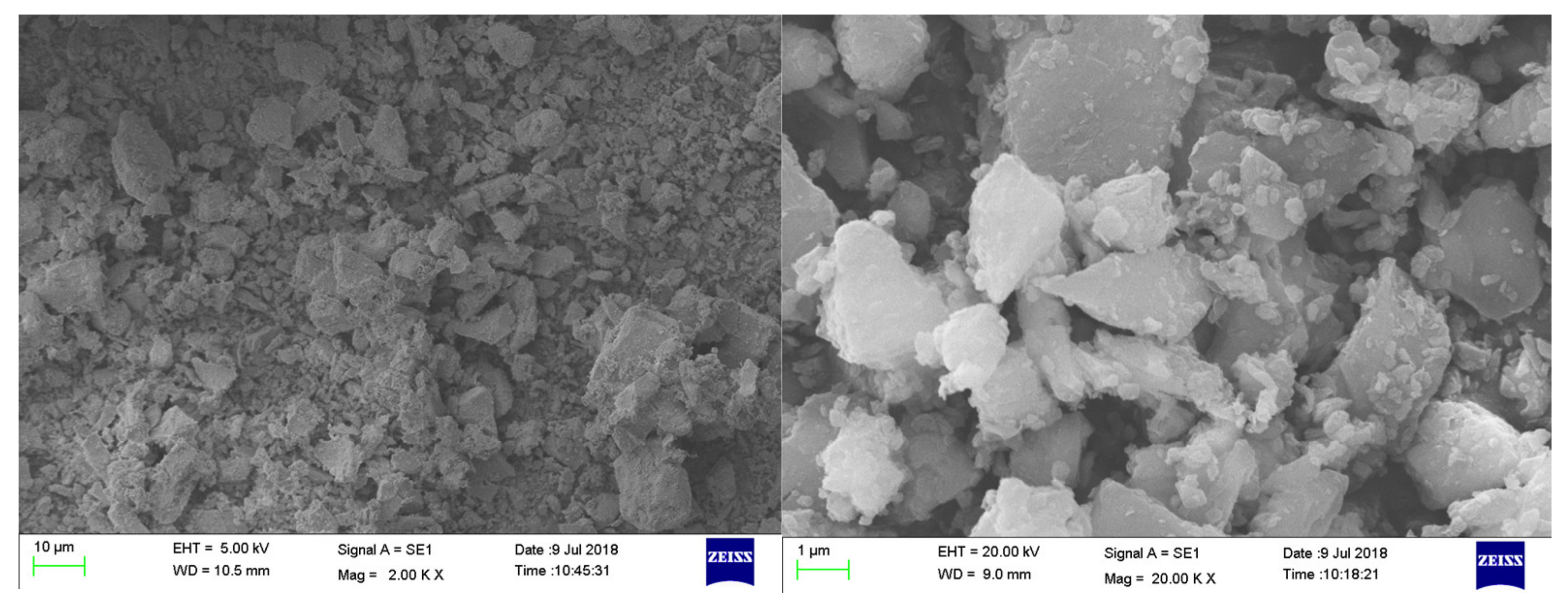
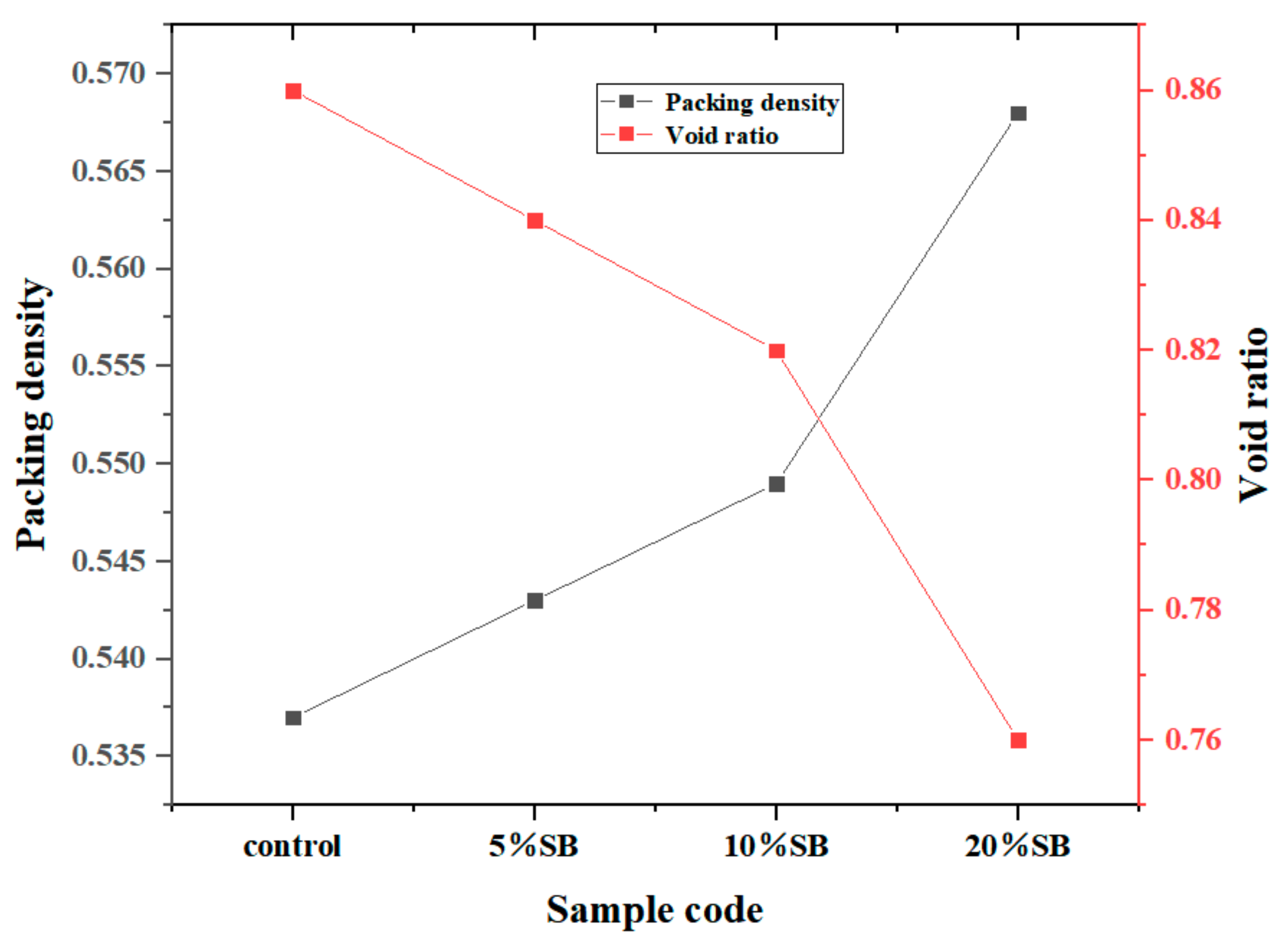
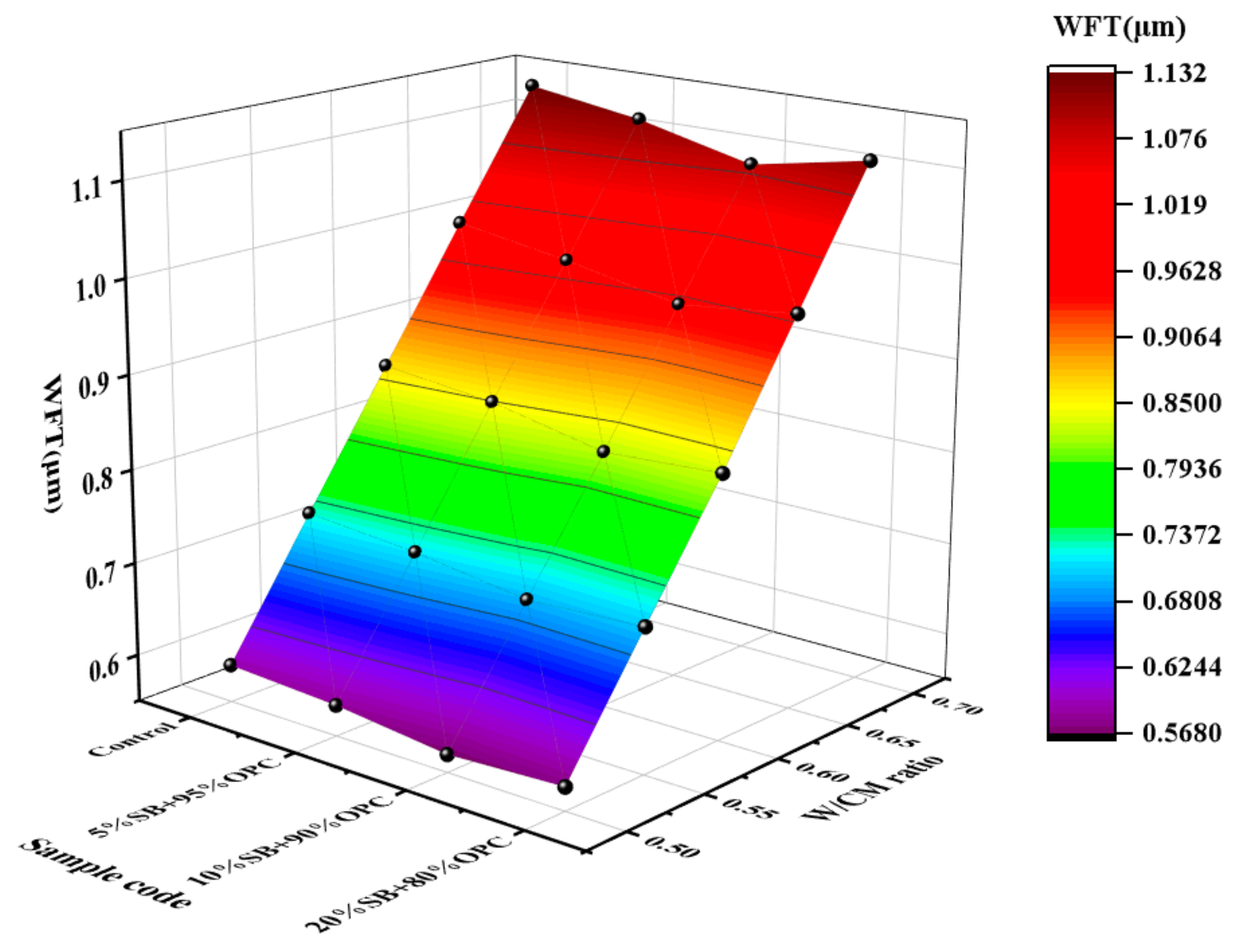
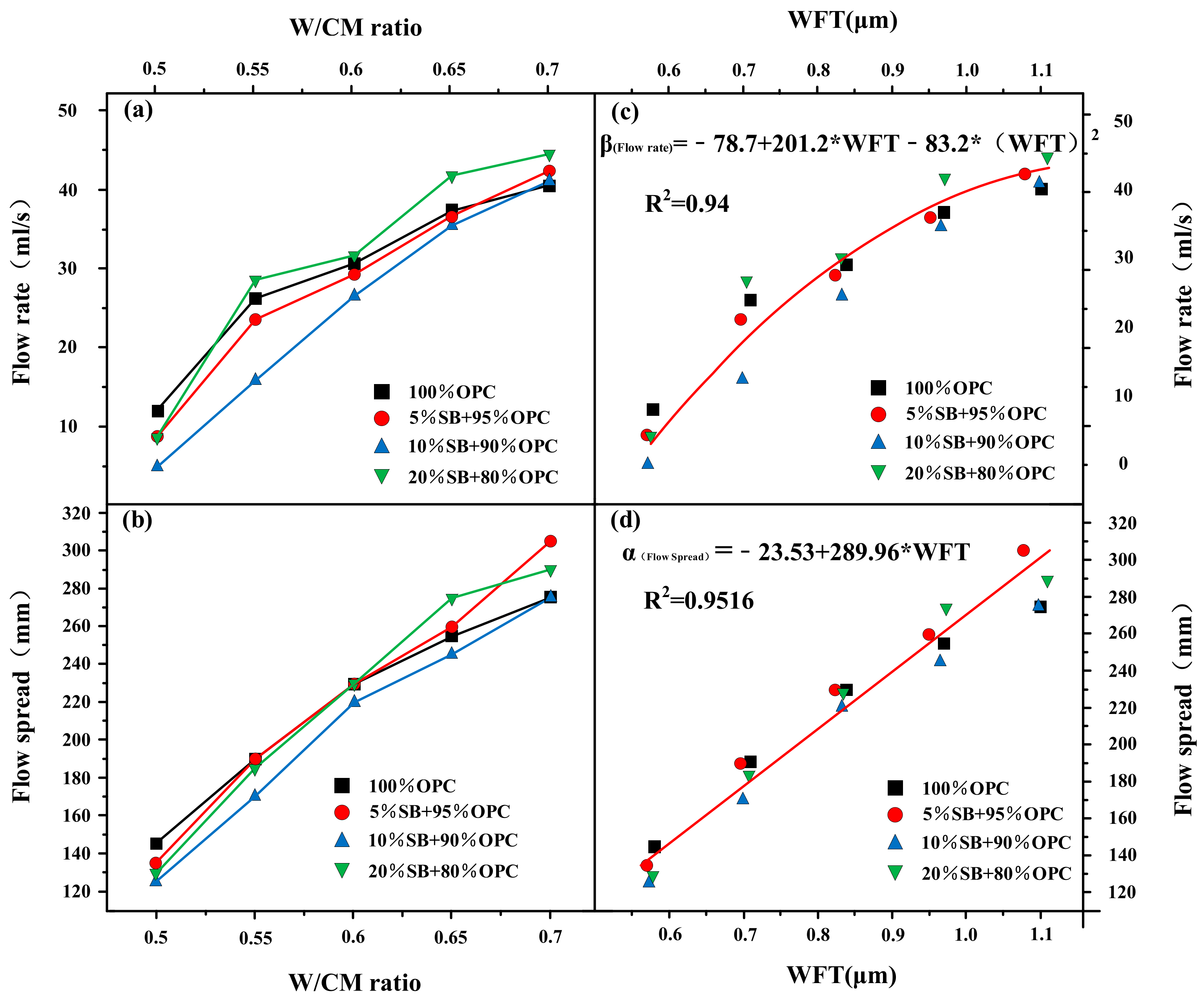
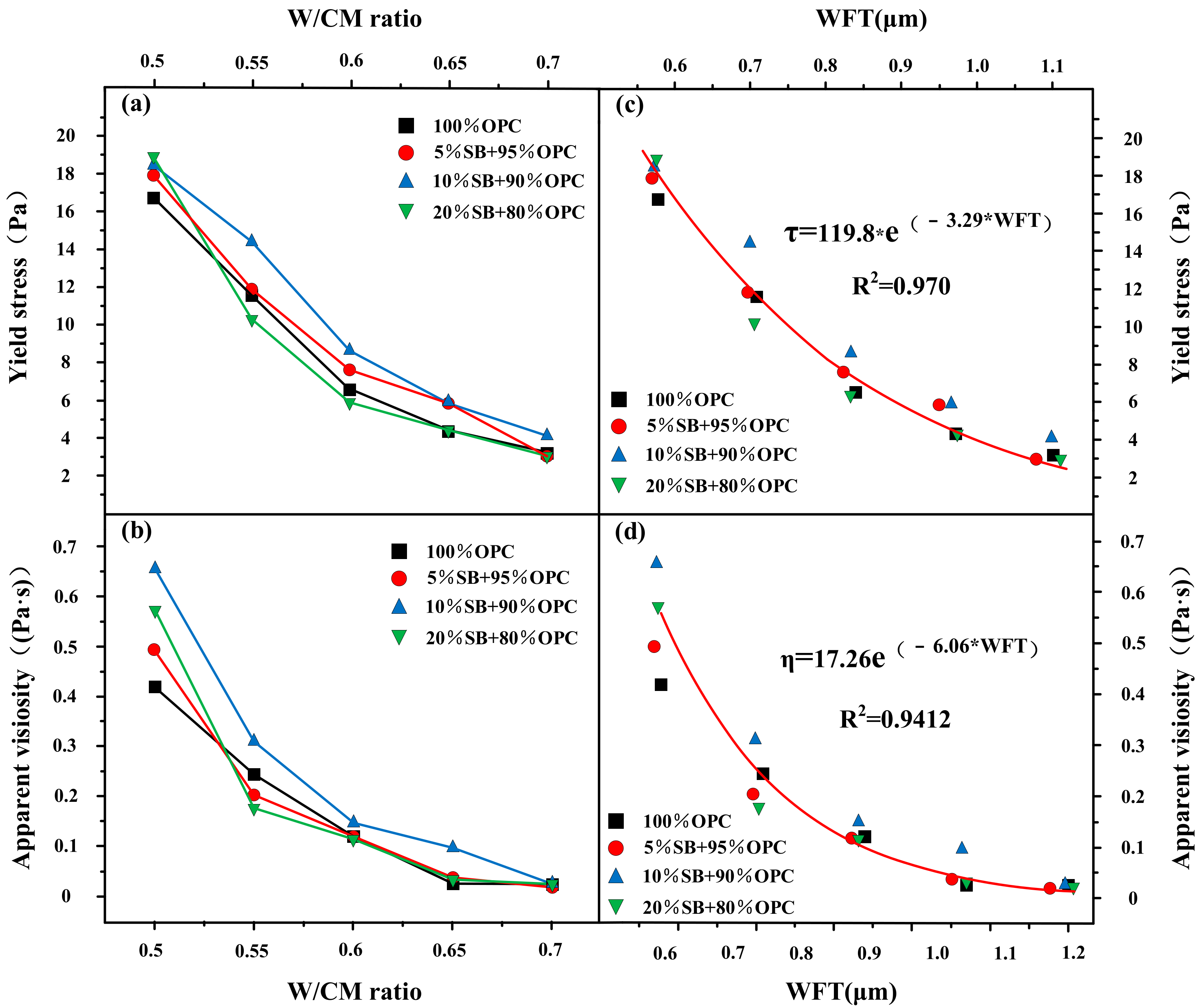
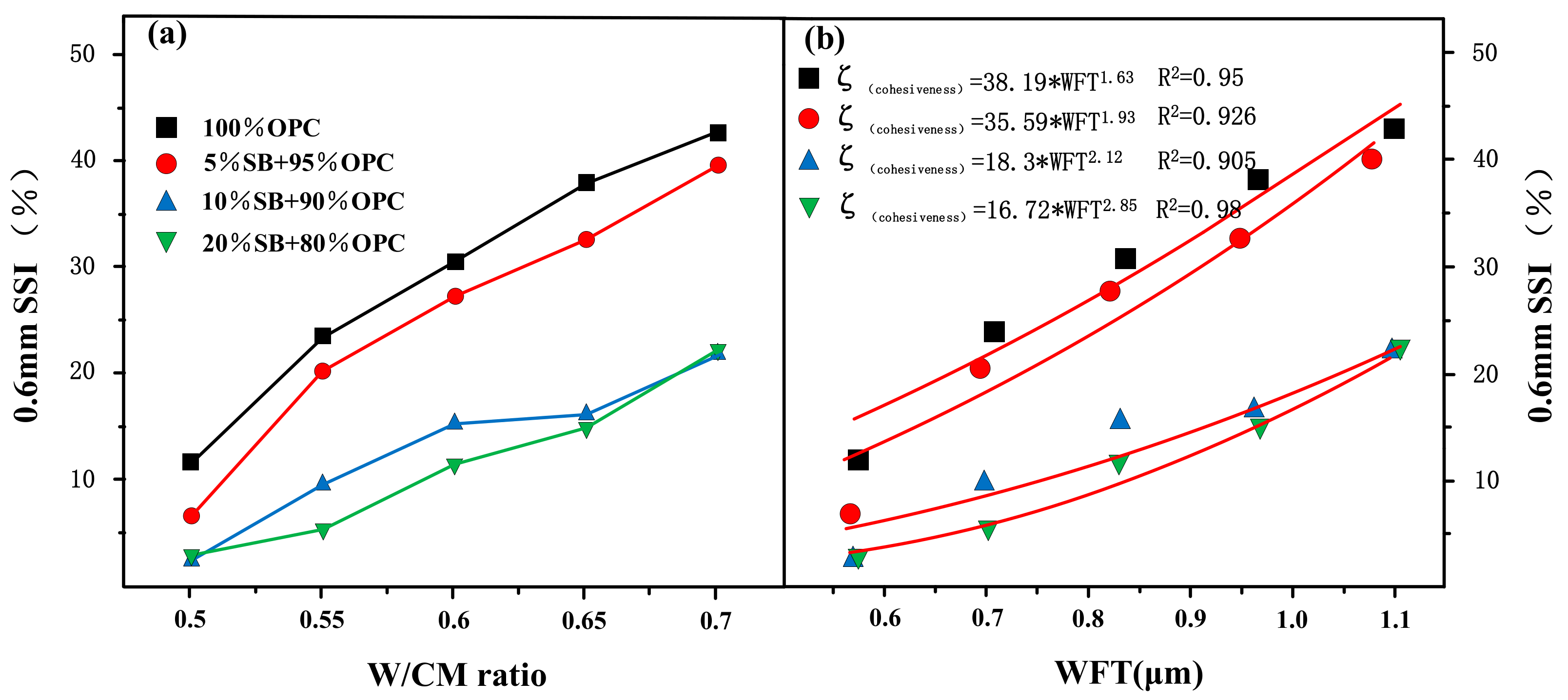
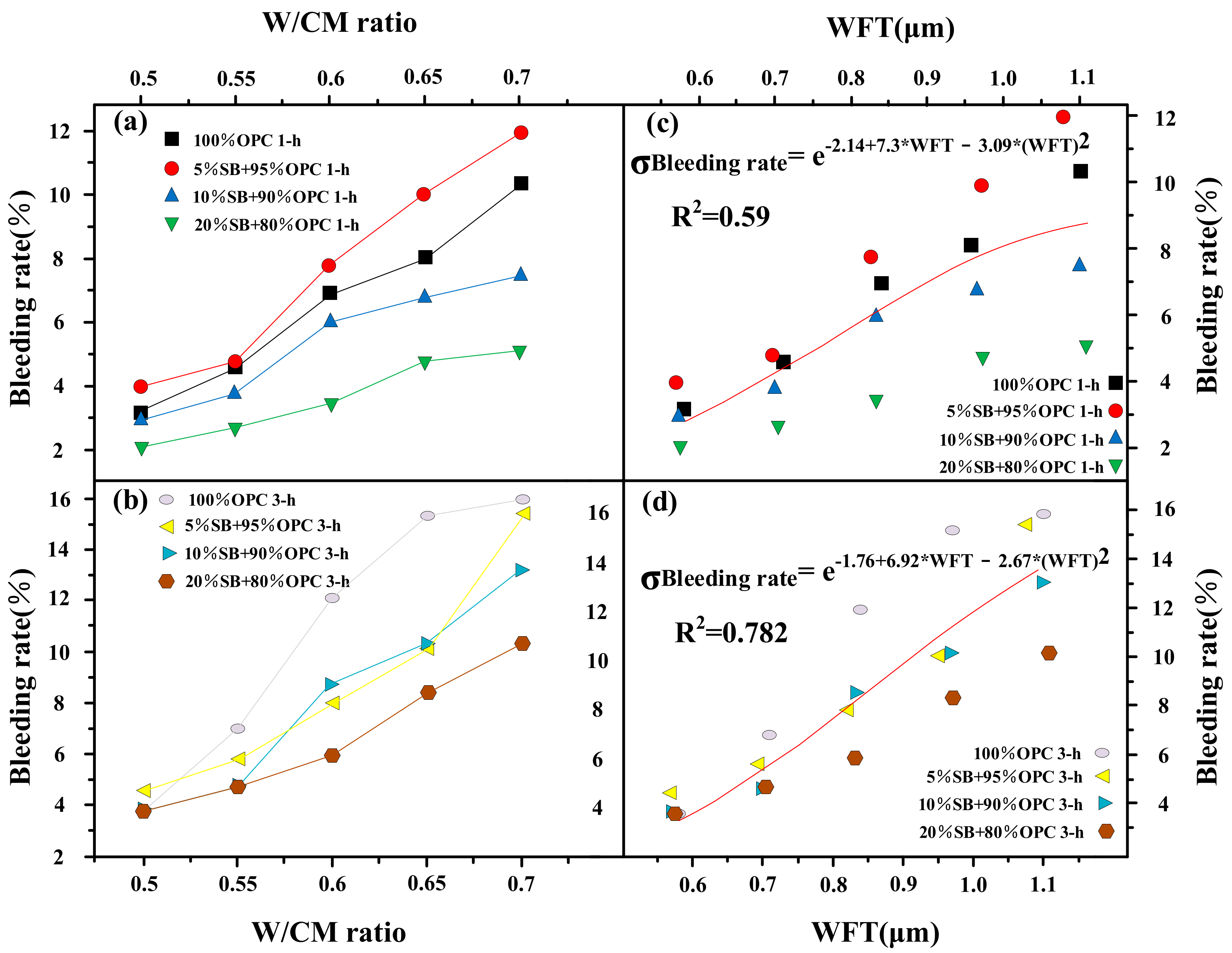

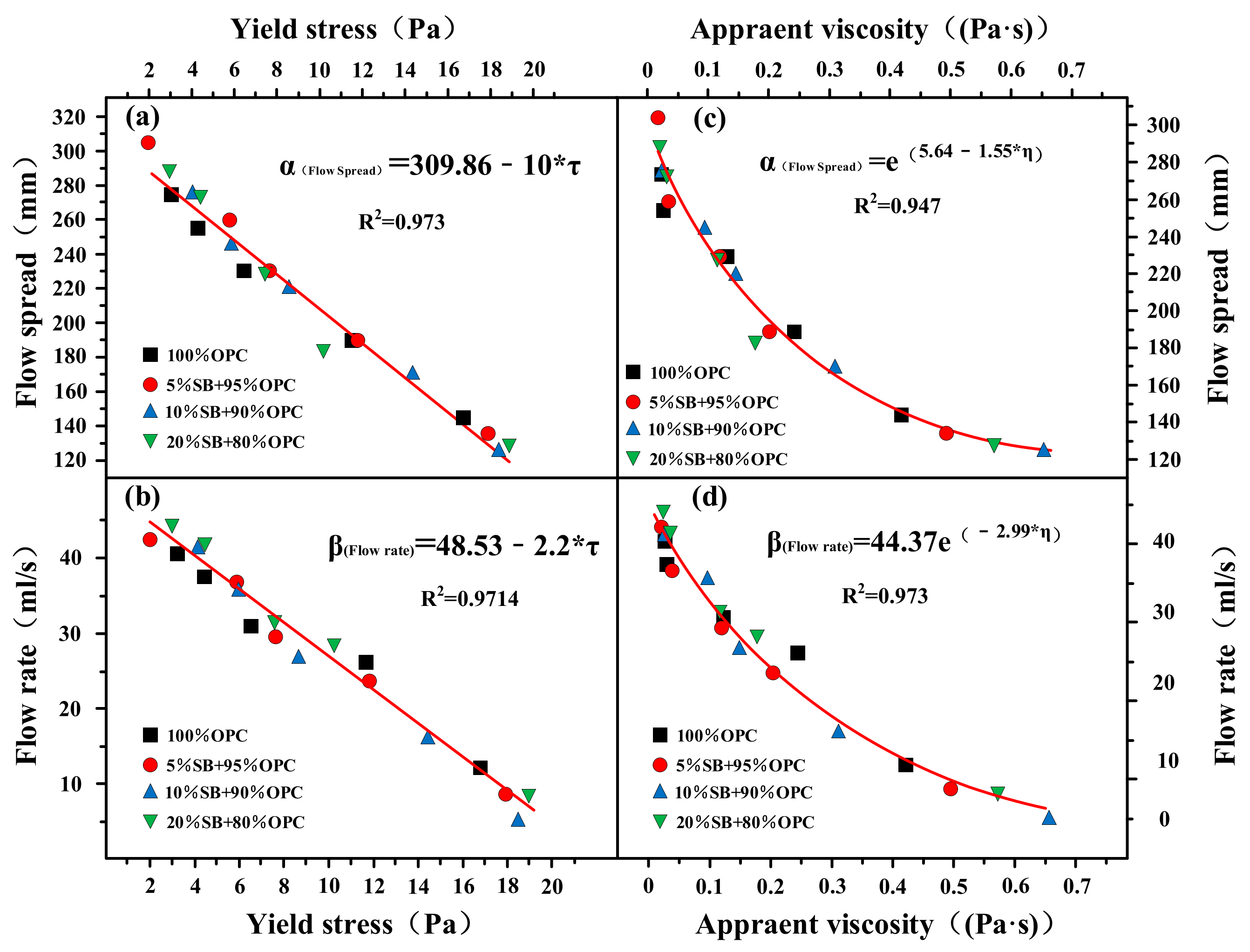

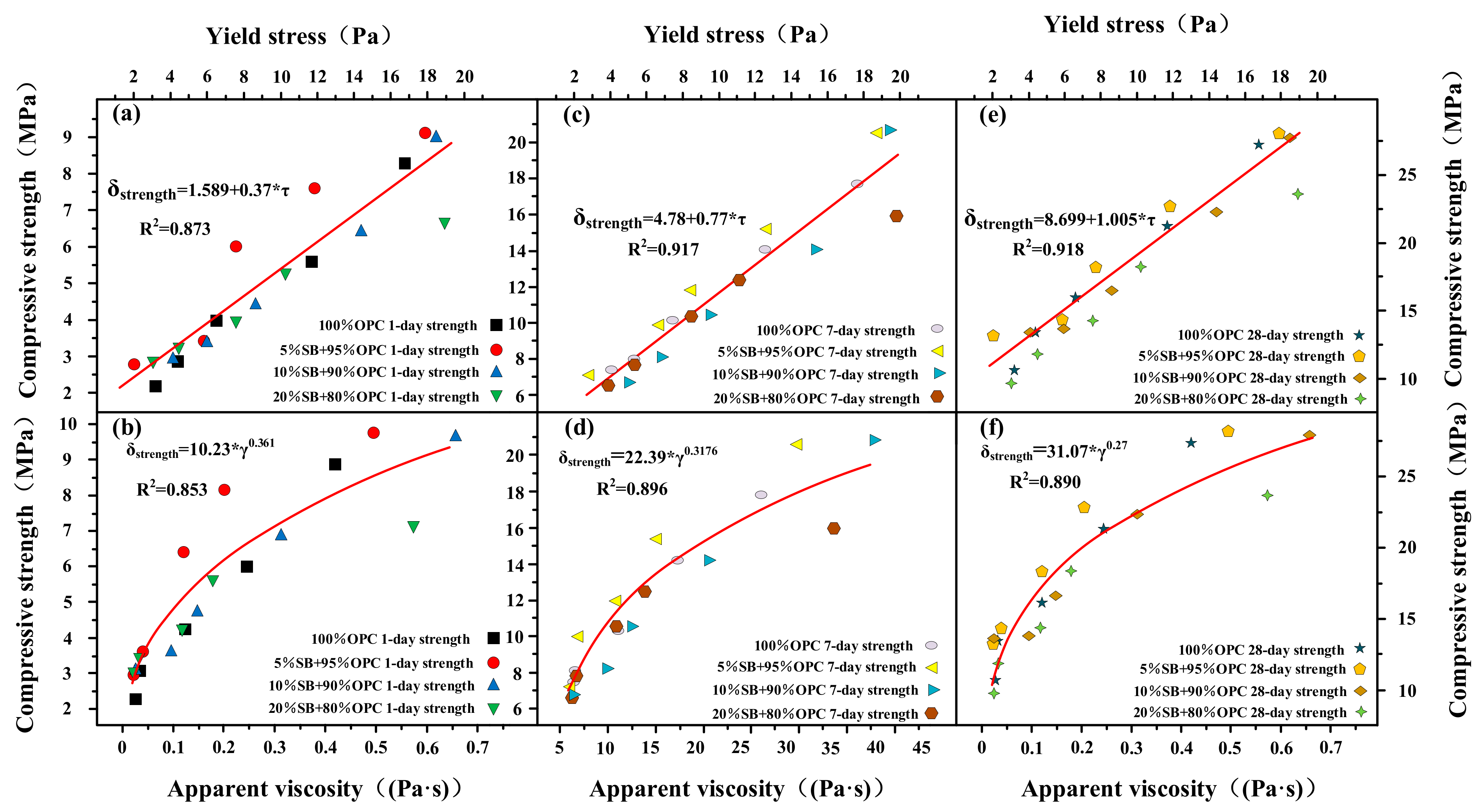
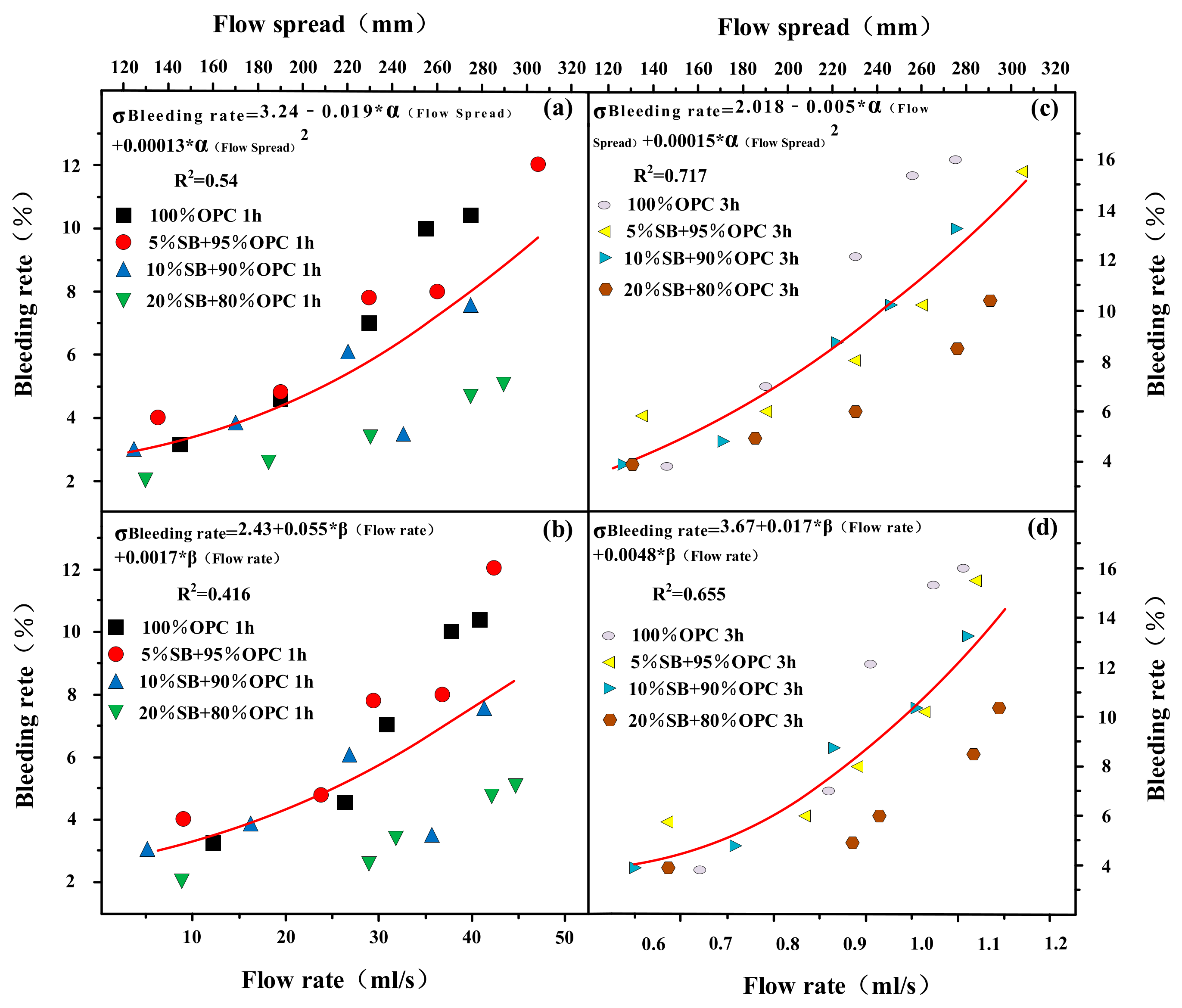
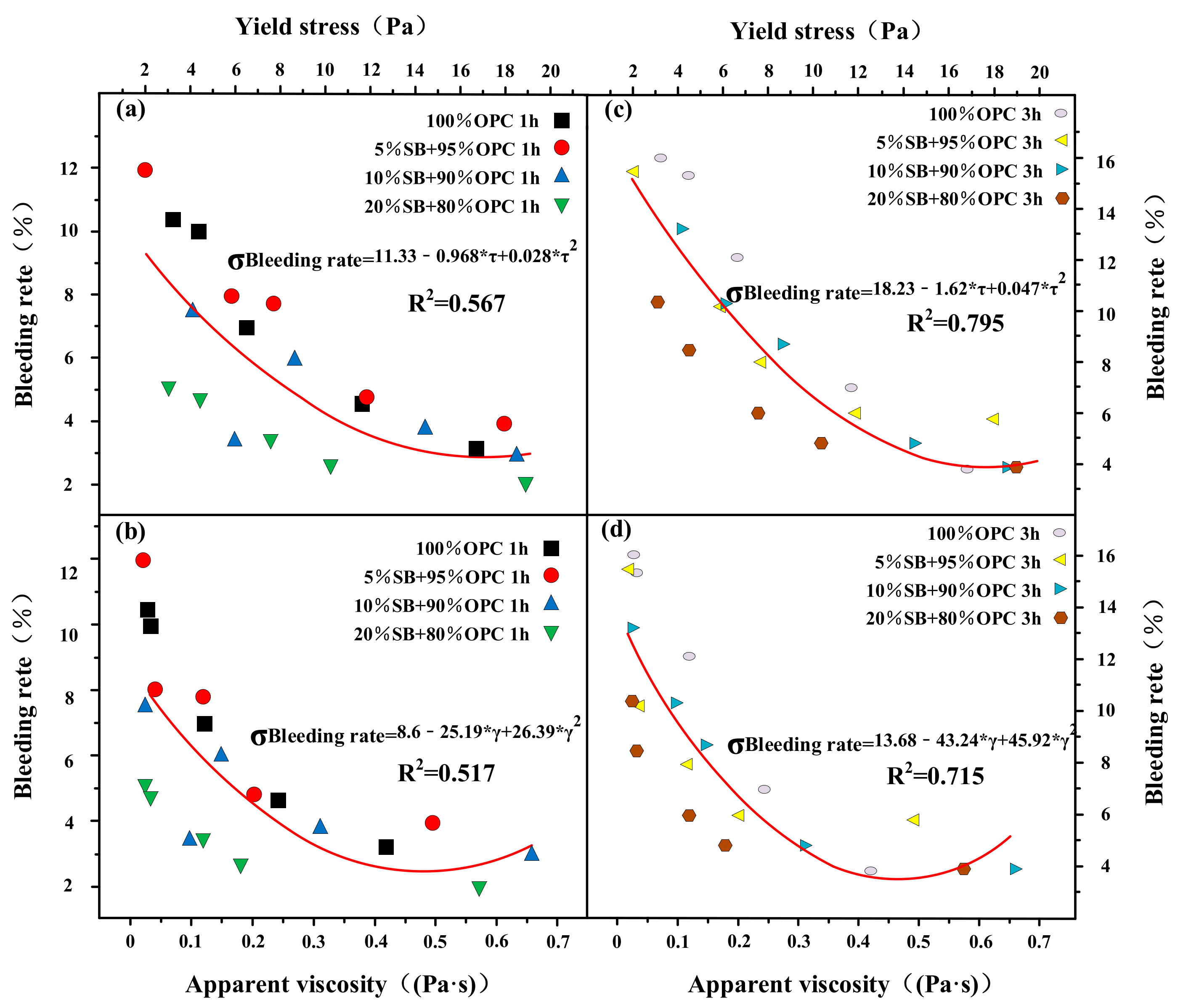
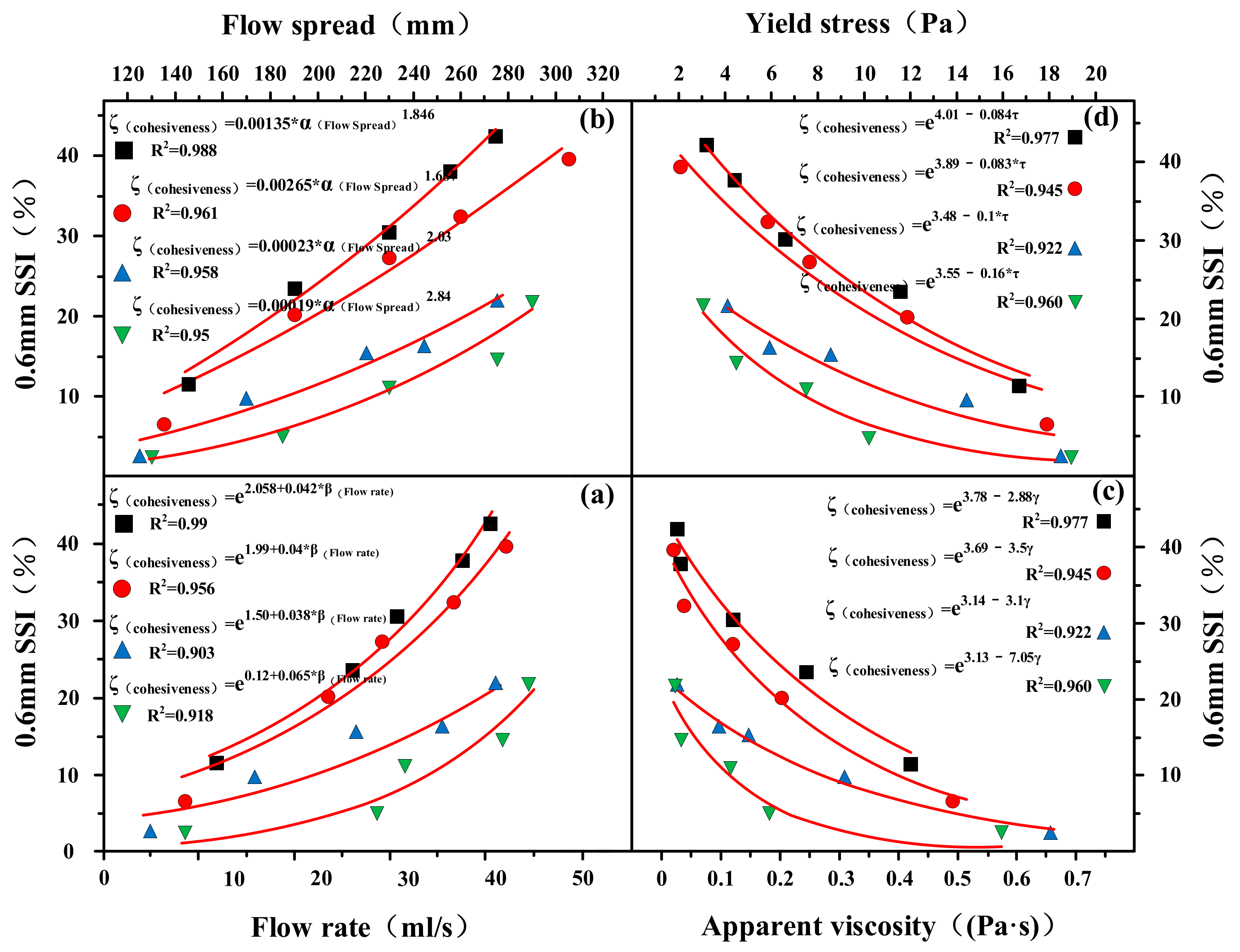
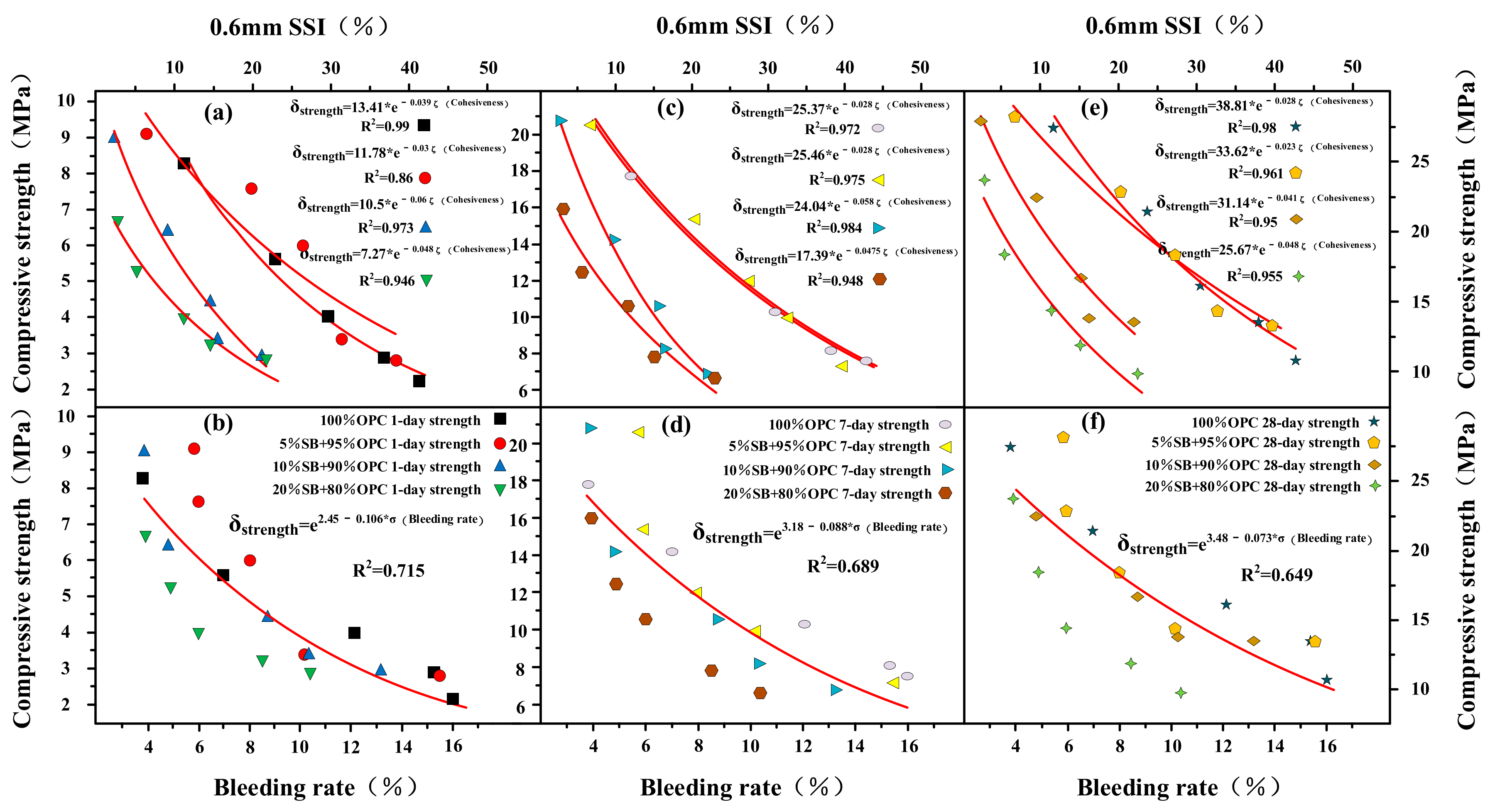
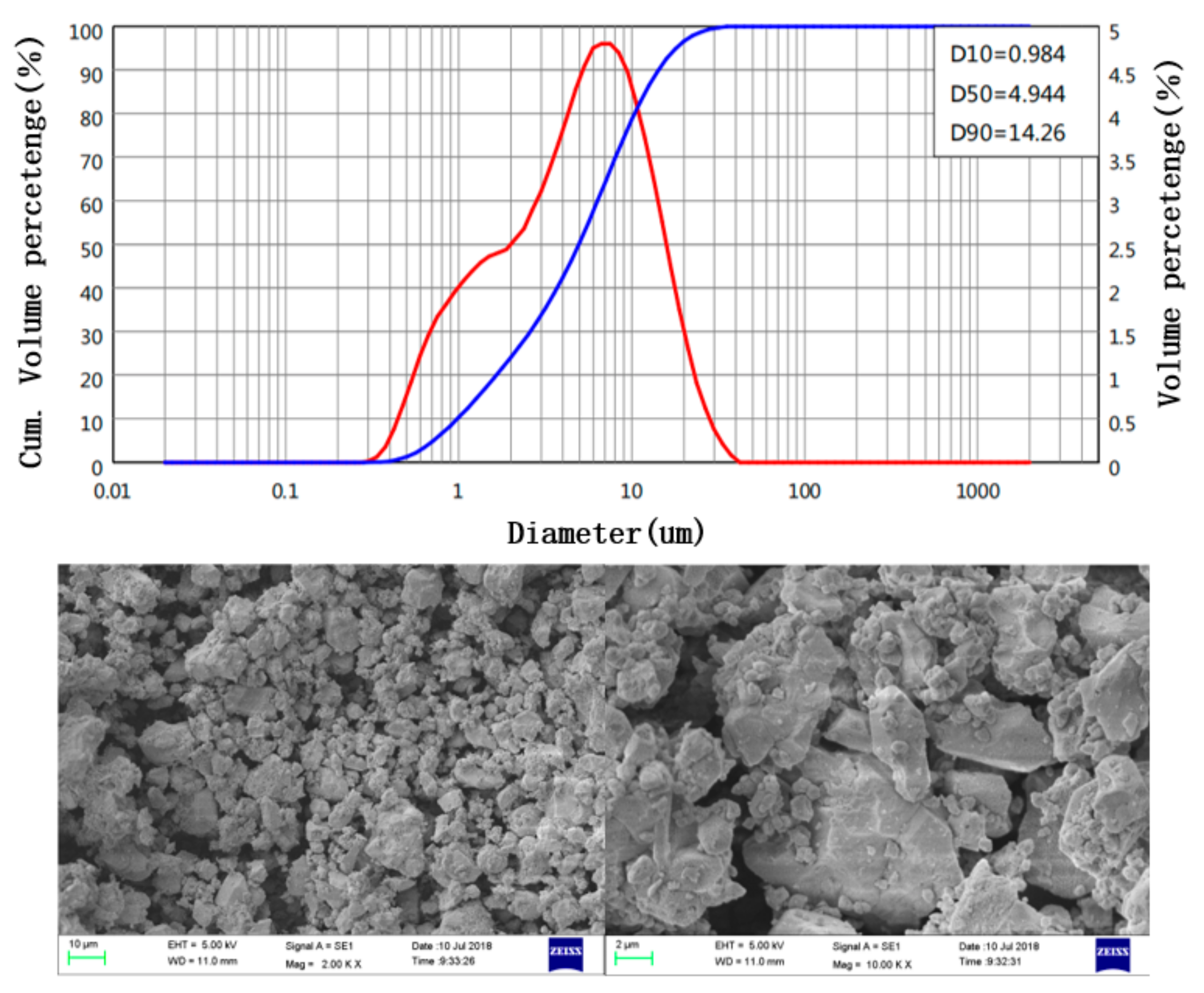
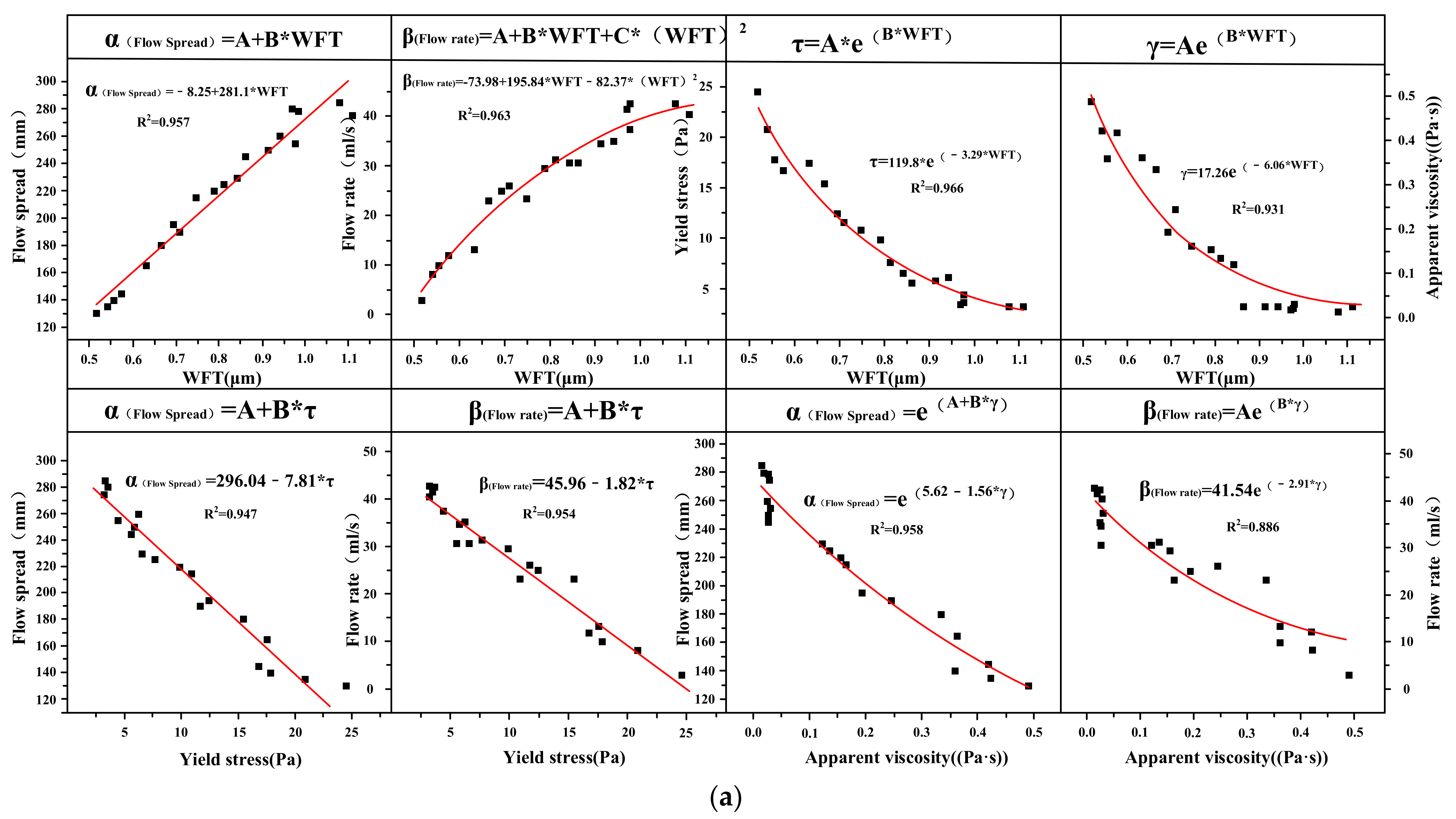
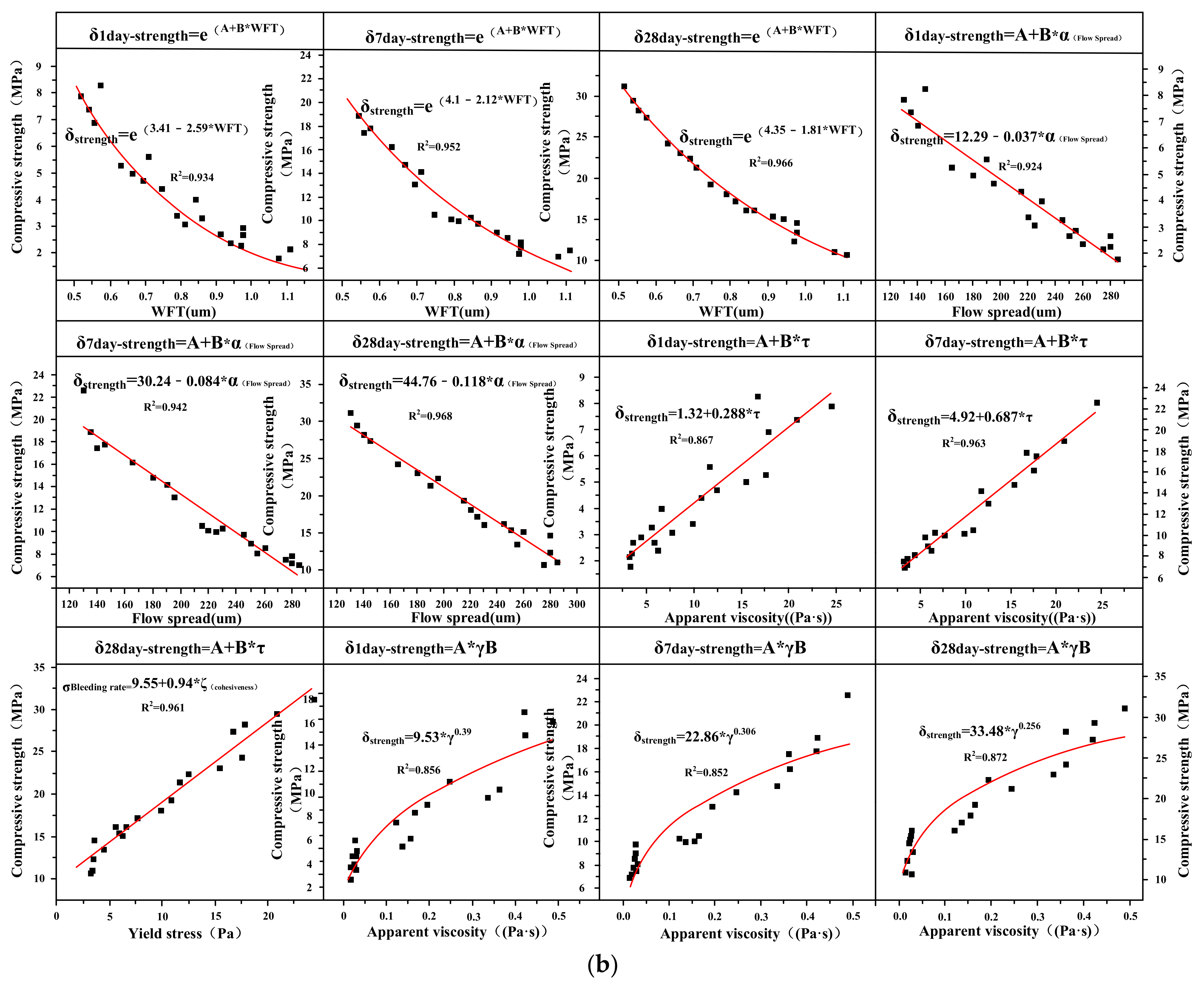
| Phase | Mass Percentage (%) | |
|---|---|---|
| OPC | SB | |
| SiO2 | 13.9 | 46.59 |
| Al2O3 | 3.05 | 14.17 |
| Fe2O3 | 4.80 | 14.91 |
| CaO | 72.37 | 10.25 |
| MgO | 1.07 | 4.875 |
| Na2O | 0.16 | 4.26 |
| SO3 | 2.63 | 0.09 |
| K2O | 0.97 | 1.55 |
| P2O5 | 0.23 | 0.64 |
| TiO2 | 0.35 | 2.34 |
| MnO | 0.30 | 0.18 |
| ZrO2 | 0.02 | 0.06 |
| SrO | 0.10 | 0.04 |
| Cl | 0.02 | 0.01 |
Publisher’s Note: MDPI stays neutral with regard to jurisdictional claims in published maps and institutional affiliations. |
© 2021 by the authors. Licensee MDPI, Basel, Switzerland. This article is an open access article distributed under the terms and conditions of the Creative Commons Attribution (CC BY) license (https://creativecommons.org/licenses/by/4.0/).
Share and Cite
Liu, H.; Tian, Z.; Fan, H. A Study on the Relationships between Water Film Thickness, Fresh Properties, and Mechanical Properties of Cement Paste Containing Superfine Basalt Powder (SB). Materials 2021, 14, 7592. https://doi.org/10.3390/ma14247592
Liu H, Tian Z, Fan H. A Study on the Relationships between Water Film Thickness, Fresh Properties, and Mechanical Properties of Cement Paste Containing Superfine Basalt Powder (SB). Materials. 2021; 14(24):7592. https://doi.org/10.3390/ma14247592
Chicago/Turabian StyleLiu, Hengrui, Zhenghong Tian, and Haoyue Fan. 2021. "A Study on the Relationships between Water Film Thickness, Fresh Properties, and Mechanical Properties of Cement Paste Containing Superfine Basalt Powder (SB)" Materials 14, no. 24: 7592. https://doi.org/10.3390/ma14247592
APA StyleLiu, H., Tian, Z., & Fan, H. (2021). A Study on the Relationships between Water Film Thickness, Fresh Properties, and Mechanical Properties of Cement Paste Containing Superfine Basalt Powder (SB). Materials, 14(24), 7592. https://doi.org/10.3390/ma14247592





